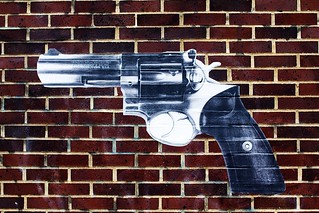| « Chicago™: Now with More Ads! | Tribune Co.'s New Owners Are Rahm Donors... Does It Matter? » |
Crime Thu Jan 03 2013
Our Kids Are Safe: Schools and Guns

Photo by Joselito TagaraoEmpathy, which lets us understand and experience others' feelings, including anguish and grief, is a critical definer of our humanity, pivotal to our civilization. So are the impulses to protect children, to want to right wrongs, and to be outraged at unfairness. It's both natural and appropriate that in the wake of horrors such as the recent Sandy Hook massacre, we privately and publicly give voice to our empathy, and to our protective, outraged, and corrective impulses. Yet it's also important to check these impulses as the basis for policy when their cause is an outlier, an extreme. Emotion drives poor governance. Policy needs to have a cool head as well as a warm heart.
Multiple shootings by deranged individuals inevitably command enormous media and public attention. In such cases, heart tends to shove head out of the way. That's apparent when mothers in the midwest say they rushed to pull their children out of school when they heard of the carnage in Connecticut 1,000 miles away, organizational leaders propose stationing armed guards at schools, or otherwise reasonable commentators say we need to jettison part of the Constitution, just to cite three examples. The circumstances make such reactions fathomable emotionally, but the facts don't support them logically. Overall, our schools are very, very, safe, and violent gunplay is a sensational but statistically small threat to our children.
The Statistically High Safety of Schools
The statistics show that it's rare, by multiple metrics, for students to be victims of violence. School-related incidents are but a sliver of all American violence, a remarkably tiny number, actually, considering the billions of personal interactions that schools compel annually. That schools are not 100% insulated from aspects of American life, including occasional violence and even shocking mayhem, does not mean that schools are unsafe; indeed, the opposite is manifestly true.
Our huge nation maintains close to 140,000 public and private schools of all sorts, from elementary and high schools to post-secondary institutions, bringing over 76 million students into daily contact with millions more faculty, principals, school workers, parents, and members of the public. Just as incidents of fatal and nonfatal violence occur in workplaces, public establishments, and almost anywhere else in the country, some such incidents inevitably occur in a fraction of those schools, ranging from school security officers committing suicide to gang drive-by shootings in parking lots, and from student attacks on teachers or other students to altercations at athletic events. If we were a village -- if all these are front-paged -- it would paint a chaotic landscape. Yet, in totality, it is a minute percentage of our millions of students who are victims of such incidents.
All in all, American schools remain extremely safe places for children, especially elementary-school students. Children in school are statistically safer, on average, than in the homes in which they live or the vehicles in which they ride. That space heater [PDF] you've been meaning to replace, that annoying car noise or fluid leak you haven't gotten around to fixing, or the cup of coffee in your SUV console as you fumble for the radio station while backing out of your driveway are more likely to be the cause of injury or death to a child than the rampage of some marauding psycho, especially at a school. Sadly, child victims of homicide are most often killed at or near home, by a family member or peer, or collateral to gang violence. Inside school is far, far safer for children than outside -- as Bill Clinton would say, it's just arithmetic -- and all the compiling and reciting of lists of violent school incidents or public mass murders in the U.S. doesn't change that.
The point of this is not to rationalize irrational rampages, nor to excuse any inexcusable abuse of firearms. Statistics and odds do not make sense out of the senseless. But perspective is necessary to go forward.
The Statistically Low Incidence of Gun Violence
Perspective is also necessary to discuss "gun violence" sensibly. Simulated mass shootings sell movies and video games, and real ones sell newspapers and boost TV ratings. But they occur in all of the foregoing in far greater proportion than in real life.
This country was christened with gunpowder, then conquered by rifle as much as by railroad. The US has been involved in bloodshed for much of its history, and has a deep cultural association with guns, much of that associated with gaining or defending freedom. Recall that within recent history, millions of Americans were in fact compelled to bear arms in the name of fighting totalitarianism. So it's unsurprising that there are at least 80 million Americans with guns in their households, and over 300 million non-military firearms in America.
Yet, domestically, by the numbers, the scores of millions of armed Americans are relatively responsible and restrained. The arithmetic, again, is inescapable: by any measure, in any given year, well over 99.999% of all those American firearms, including semi-automatic weapons, will not be used in any crime whatsoever, let alone homicide, and well over 99.999% of all firearm owners will commit no crime whatsoever with their firearms. The hard facts are that the vast, overwhelming majority of gun owners are not violent criminals, that statistically very few gun owners commit crimes with their guns, and that the vast, overwhelming majority of guns are kept for defense, hunting, sport, or hobby without ever being used in any crime, let alone murder. Thus, any tightening of gun laws in response to the acts of a small minority or one or more sensational, horrible incidents restricts primarily the law-abiding, which is one reason such measures face such resistance.
True, guns are far more often the weapon of choice for violent crime in the U.S. than in many Western countries without so deep a gun tradition. But comparison with a fraction of other countries is inapt; the U.S. is more culturally diverse and economically unequal than Japan or most European nations, and its murder rate is not, by world standards, high; the U.S. is in fact considerably below the median and many countries with much lower gun ownership nevertheless have higher murder rates.
The odds are 100% that I will die. But the odds of intentional homicide being the cause of my demise, or yours, or your child's, are less than ½ of one percent, and a firearm homicide less likely still. These small odds drop much further if you do not live in a high-crime neighborhood, if you or your family are not involved in the illegal drug industry, and if you and your family are not affiliated with a gang. Moreover, most murders are not impersonal.
The 24/7 coverage of the sensational incidents that deviate from this pattern obscures that the occurrence of a Stranger Danger committing homicide, let alone mass gun homicide, and especially in a public place in a suburb or exurb, is, statistically, a nearly off-the-charts, freakish occurrence, even in gun-toting America. It is enormously unlikely to happen to me, to you, or to our children or grandchildren. The average American schoolchild is at far greater risk of killing himself or herself than of falling victim to a random marauder, and at far greater risk of death by simple accident than by any form of human violence.
Risk and Policy
The above does not mean that the risk to children in school is zero, or that the risk to anyone of gun violence is zero, or that the risk that a tiny fraction of gun owners, regardless of class of weapon, will abuse them, is zero. But few risks are.
What it means is that we should bear in mind, to begin with, that murder is a very uncommon cause of death.
What it means is that in all likelihood, you are not going to be shot. Nor is your child.
What it means is that your school is very safe.
Every day that we wake up, there is some small chance that something unlikely, unexpected, and tragic will happen to us, or to someone we love. We must not paralyze ourselves because of the small chance that they may occur, nor terrorize ourselves when they do. To orient our lives or our society around awful but low-probability events is to inherently discount or even miss entirely what is more likely or even more important.
Statistics are of little or no comfort to those devastated by the occurrence of the improbable. To them, our hearts pour out, as they should. For the victims, child and adult alike, we grieve, as we should. Facts and numbers don't lessen a horror or a tragedy to any degree. But they should be of at least equal impact, in guiding our long-term reactions and policy decisions, than the impulsive reactions driven by our natural and laudable humanity.












alan miller / January 3, 2013 6:02 PM
are you kidding me? if sensible gun restrictions such as the banning of assault weapons and making background checks mandatory can protect lives, why wouldn't you put those measures in place? some would go further, but i do not see how we do not go that far. there is no constitutional right to own an assault weapon any more than there is to make a nuclear bomb or yell "fire" in a crowded theatre. our liberties must be balanced against our responsibilities and the common good.